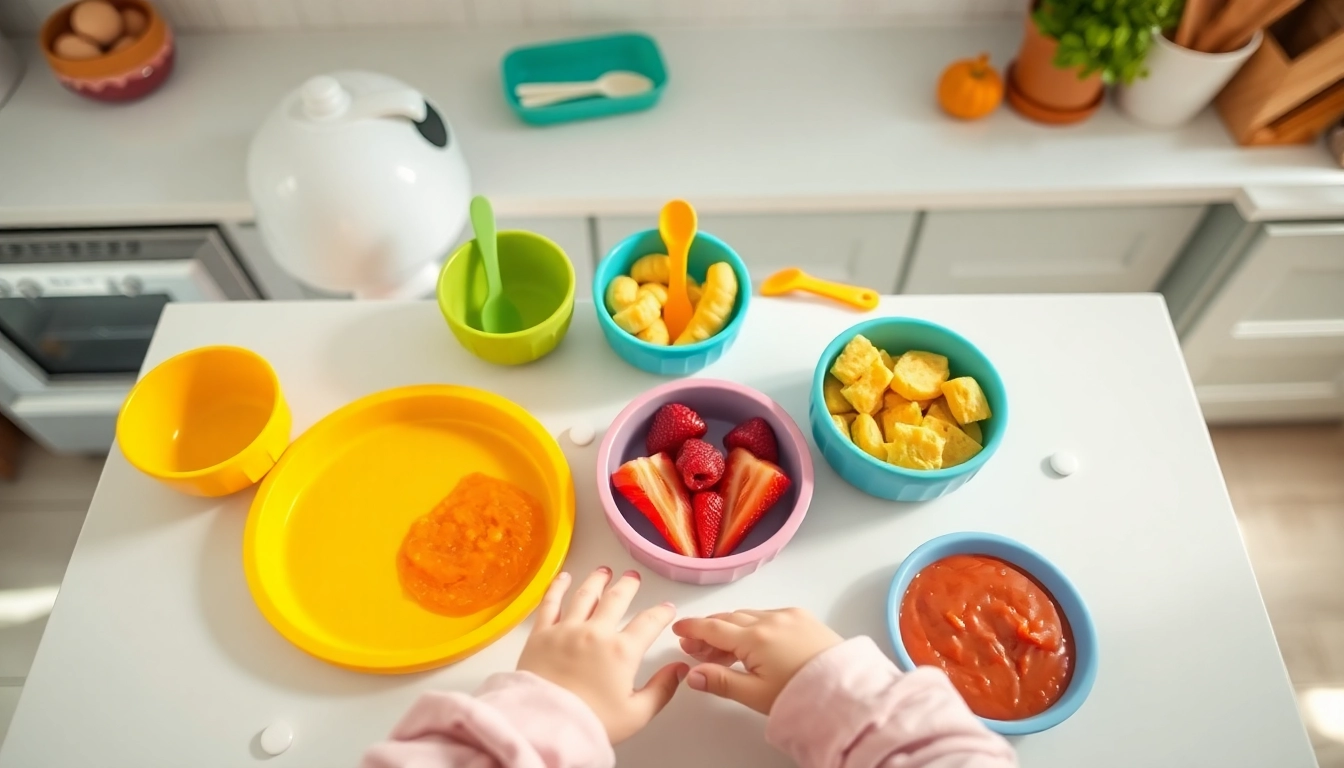Understanding Baby Weaning Foods and Their Importance
Introducing solid foods to your baby is a pivotal milestone that marks the transition from exclusive milk feeding to exploring a variety of tastes and textures. Baby weaning foods, often referred to as complementary foods, play a crucial role in supporting healthy growth, nutritional balance, and developmental progress during this phase. In Italy, renowned for its rich culinary tradition and commitment to quality, parents have access to a wide array of high-quality, safe, and nutritious baby foods that respect cultural heritage while embracing modern dietary standards. For an in-depth look into this world, visit Baby weaning foods and discover how Italy’s expertise ensures the best for your child’s nutrition.
As parents navigate the complex landscape of baby nutrition, understanding the essentials of weaning foods becomes vital. These foods must cater to evolving nutritional needs, support motor and sensory development, and introduce babies safely to new flavors and textures. The importance of choosing the right products is underscored by the Italian commitment to quality, where ingredients are carefully selected, and safety certifications are rigorous. This guarantees that each spoonful delivers the proper nutrients—proteins, carbs, fats, vitamins, and minerals—necessary for optimal growth. Moreover, early exposure to diverse flavors fosters healthy eating habits that can last a lifetime, making the initial food experience both nourishing and enjoyable.
Nutritional Needs During Weaning
During the weaning phase, typically between 6 and 24 months, a baby’s nutritional requirements change significantly. They need higher amounts of iron, zinc, and calcium, along with a balance of macronutrients to support rapid growth and brain development. Baby foods that are made with Italy’s finest organic and certified ingredients ensure these needs are met with natural, wholesome options. Nutrients are not only sourced from cereals and vegetables but also from high-quality proteins like poultry and fish, and healthy fats. The emphasis is on minimal processing, preserving the natural integrity of ingredients to provide maximum nutritional value.
Incorporating a variety of textures—purees, mashed, and small soft pieces—encourages the development of chewing and swallowing skills. It’s important to introduce new flavors gradually, respecting the baby’s palate and tolerance. Expert tips suggest offering a colorful plate that includes fruits, vegetables, grains, and proteins from trusted Italian producers, ensuring safety and flavor authenticity. The use of certified silicone accessories, such as specialized bowls and plates, facilitates mealtime independence and makes feeding a stress-free experience for both parent and child.
Common Challenges in Introducing Baby Weaning Foods
Parents often encounter several challenges when introducing baby weaning foods. Common issues include food refusal, digestive discomfort, allergic reactions, and managing mealtime fussiness. Food refusal might stem from unfamiliar textures or flavors, but introducing a gradual progression of textures, alongside engaging presentation, can significantly improve acceptance. For example, offering colorful silicone plates and bowls designed with appealing shapes and safe materials can stimulate interest and curiosity.
Digestive discomfort may be alleviated by selecting easily digestible, certified organic ingredients that are free from additives and preservatives. Allergies require careful observation and gradual introduction of potential allergens, always under pediatric guidance. Fussy eaters benefit from a calm, engaging environment where mealtime is a positive experience, not a battleground. Large-scale studies suggest that early exposure to diverse, high-quality foods positively influences long-term eating habits and reduces the risk of picky eating behaviors.
Addressing these challenges calls for a combination of patience, knowledge, and high-quality tools. For instance, utilizing ergonomic silicone utensils and suction bowls supports self-feeding, fostering independence, and reducing mess. Monitoring developmental milestones, such as increased acceptance of textured foods and improved motor coordination, helps gauge success. Learning from tailored approaches and expert advice ensures a smoother transition through the various weaning stages.
Selecting the Best Baby Weaning Foods in Italy
Genuine Swiss and Italian Ingredients for Healthy Porridges
Italy’s culinary heritage and rigorous quality standards make it a leader in safe, genuine baby foods. Grown from the rich soil and crafted with care, Swiss and Italian ingredients are renowned for their purity and nutritional potency. Baby porridges made from a blend of organic Italian cereals and Swiss grains provide a wholesome start to solids, offering balanced energy and essential nutrients. Brands committed to authenticity utilize local, sustainable ingredients, ensuring that every spoonful maintains authentic flavor and safety standards.
Organic and Genuinely Certified Baby Foods
Certification ensures that baby foods meet strict standards for safety, transparency, and quality control. Italian producers prioritize organic farming practices, avoiding pesticides, synthetic fertilizers, and GMOs. These foods are often tested for contaminants and adhere to European regulations, giving parents peace of mind. Furthermore, innovative packaging with certified silicone accessories in vibrant designs encourages independent eating while maintaining hygiene and safety. Such products are BPA-free, free from phthalates, and engineered to withstand daily use without compromising safety or aesthetics.
Balancing Flavors and Textures for Different Age Groups
Effective weaning requires carefully curated flavor profiles and textures tailored to developmental stages. Early purees gradually give way to mashed foods, while small, soft chunks prepare the palate for table foods. Italian brands excel at balancing traditional flavors—like mild herbs, fruits, and vegetables—with modern nutritional insights. The goal is to introduce a variety of tastes while avoiding overwhelming the baby, fostering curiosity and acceptance. These strategies promote readiness for family meals and help develop a positive association with food that lasts into later childhood.
Essential Silicone Accessories for Baby Weaning Foods
Why Silicone Pates and Bowls Improve Mealtime
Silicone accessories have revolutionized baby feeding, offering a safe, durable, and hygienic alternative to traditional plastic or ceramic ware. Silicone’s flexibility, heat resistance, and non-porous surface make it ideal for serving baby weaning foods. Non-slip silicone bowls and plates help prevent spills, while multi-compartment designs encourage variety in a single meal. Silicone pates and suction bowls firmly adhere to highchair trays, allowing babies to self-feed with confidence and independence, promoting motor development.
Features of Certified Silicone Accessories (BPA-Free, Safe)
Certified silicone accessories for baby weaning are rigorously tested to guarantee they’re free from harmful chemicals like BPA, ftalates, and lead. Designed with safety in mind, they also adhere to European standards for food contact materials. These accessories are microwave, freezer, and dishwasher safe, making preparation and cleaning effortless. Their vibrant, arched or rainbow shapes paired with smooth edges appeal visually and tactilely to infants, stimulating sensory exploration and making mealtime engaging.
How Silicone Accessories Support Development and Independence
Silicone utensils and accessories foster independence by enabling babies to grasp, scoop, and feed themselves. Ergonomic designs with textured handles teach fine motor skills, while varied textures support sensory learning. As babies experience success in self-feeding, confidence and coordination grow. These accessories also assist in teaching important skills for later stages, such as using a spoon or fork, preparing children for more complex self-feeding activities. Their durability and safety ensure these tools are companions throughout growth, nurturing autonomy at every step.
Preparing and Serving Baby Weaning Foods Effectively
Tips for Introducing New Flavors and Textures
Gradual introduction of flavors and textures is key to successful weaning. Start with single-ingredient purees that highlight natural tastes, then slowly diversify with combinations. Incorporate local Italian fruits like pears, apples, and peaches, and vegetables like zucchini or carrots, to introduce mild, familiar flavors. Use silicone baby plates with compartments to serve small portions of different foods side-by-side, encouraging acceptance of variety. Repeated exposure and patience increase the likelihood of acceptance, especially when mealtime remains positive and stress-free.
Creating a Calm and Engaging Mealtime Environment
A tranquil, distraction-free environment enhances focus and enjoyment during meals. Use colorful, appealing silicone tableware to stimulate interest. Engaging your baby with calm interactions, talking, or singing creates positive associations with eating. Establishing routines and sitting at a consistent, comfortable spot further reinforces good habits. Avoid pressuring the child; instead, celebrate small successes to foster a healthy relationship with food.
Monitoring Baby’s Reactions and Adjusting Diet
Observation is fundamental in tailoring a balanced diet. Watch for signs of food intolerance or allergies, such as rashes, swelling, or gastrointestinal discomfort. Be attentive to preferences and tolerance levels, adjusting textures and flavors accordingly. Keeping a feeding diary can help identify patterns and guide future choices. Collaboration with pediatricians or nutritionists ensures that nutritional gaps are addressed and that food introduction aligns with developmental milestones.
Measuring Success: Key Metrics for Baby Weaning Progress
Assessing Nutritional Balance and Tolerance
The primary goal during weaning is to ensure that the baby receives a nutritionally complete diet. Regular pediatric check-ups and growth charts help monitor weight, height, and developmental progress. Blood tests may be necessary to verify iron or vitamin D levels. Food tolerance is assessed through observations of digestion, skin reactions, and overall well-being. Employing high-quality, certified Italian baby foods ensures that these assessments are based on safe and consistent nutritional parameters.
Tracking Baby’s Developmental Milestones
Progress in motor skills (such as grasping, pinching, and swallowing), speech development, and social interactions can serve as markers of successful weaning. Introducing a variety of textures, promoting self-feeding, and encouraging social eating habits foster these milestones. Documenting these achievements helps parents and caregivers tailor future feeding plans, ensuring ongoing growth and development.
Gathering Feedback for Continuous Improvement
Open dialogue with healthcare providers and attentive observation at home enable continuous improvement. Adjustments in food textures, presentation styles, and accessory tools are often needed as the child progresses. Feedback from the baby, such as cues of happiness or discomfort, guides evolution in feeding strategies. Staying informed with Italian Food News or similar resources broadens understanding of new products and practices, ensuring the child’s diet remains fresh, safe, and appealing.




